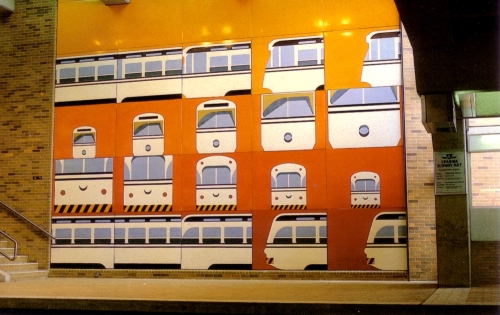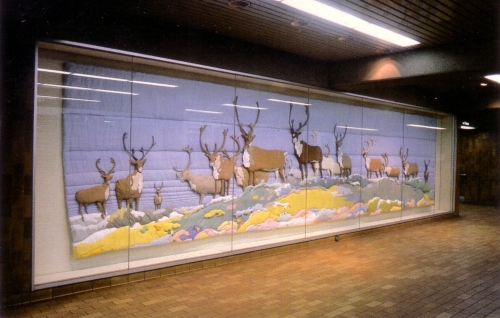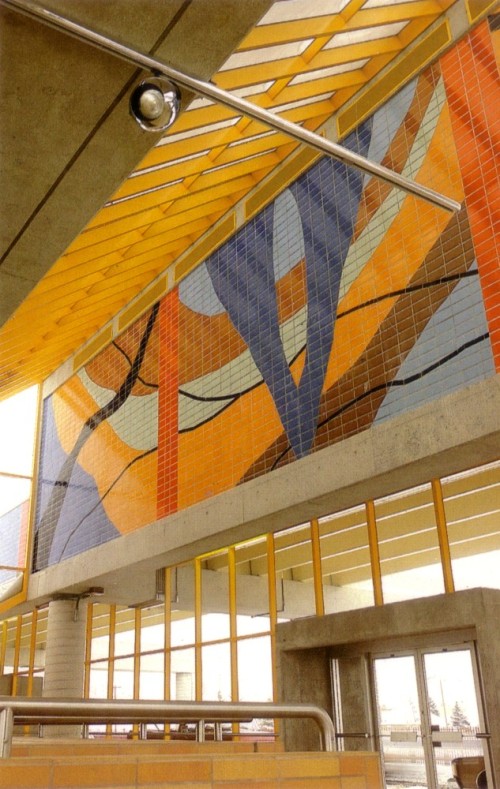A defining characteristic of many great cities is their subway system (or metro/underground), and the primary points of contact for those using the system are its stations. From the earliest stations in the London Underground, the Paris Metro and the New York Subway to the recent creations of Santiago Calatrava, Norman Foster and Renzo Piano, a city’s subway stations are important elements of civic identity and pride for both residents and visitors.
Toronto’s relationship with its subway stations has been decidedly mixed since the system’s opening in 1954. The early stations on the Yonge, University and Bloor-Danforth lines, based on standardized designs by John B. Parkin Associates, were intended to be functional: clean-lined, durable and efficient. But by the late 1960s, despite increasingly lurid combinations of coloured wall tiles, Toronto’s stations began to seem overly utilitarian and sterile, particularly compared to the avant-garde stations of Montreal’s new Metro.
To address this aesthetic deficit, in 1974 the Toronto Transit Commission (TTC) decided to engage architects and artists in the design of the eight stations comprising its new Spadina Line. Three architectural firms were selected and assigned two stations each: Arthur Erickson Architects (Eglinton West and Yorkdale), Adamson Associates (Spadina and Glencairn) and Dunlop Farrow Aitken (Dupont and Lawrence West). The TTC retained architectural control over the St. Clair West and Wilson stations due to their technical complexities. Nine Ontario artists were selected from over 400 entrants in an open competition: Ted Bieler, Claude Breeze, Louis de Niverville, Michael Hayden, Rita Letendre, Gordon Rayner, James Sutherland, Joy Wieland and Gerald Zeldin.
The Spadina Line opened with great fanfare in January 1978. Dupont, Eglinton West and Yorkdale are generally considered the most successful stations, combining architectural verve with vibrant and well-integrated artwork. Dupont is the most fantastical of the three, a wondrous subterranean world of organically curving walls lined in shimmering melon-coloured tiles, which culminate at platform level with James Sutherland’s enormous glass-mosaic murals of psychedelicized plant life. Station entrances are Plexiglas bubbles framed in bright orange metal, startling insertions in their drab, workaday surroundings; hulking black steel gates by Ron Baird guard the electrical substation adjoining the northwest entrance.
Viewed from Eglinton Avenue, Arthur Erickson’s Eglinton West station appears as an octagonal glass-walled pavilion, topped with a concrete waffle-slab roof and pyramidal skylights. Once inside, though, a series of terraced staircases descend through the station to platform level, which features Gerald Zeldin’s well-loved Summertime Streetcar murals of abstracted TTC streetcars. The station’s refined details and limited materials palette of concrete, glass, stainless steel and variegated orange brick contribute to a visual serenity that counters the clamour of trains, busses and people.
Yorkdale station, also by Erickson, is a striking visual metaphor for speed and motion, a long, slim, stainless-steel-clad extrusion punched with oval windows like a subway car and capped by a vaulted glass roof running the entire length of the station. The slender steel roof arches once supported Michael Hayden’s stunning Arc en Ciel, a 570-foot-long light sculpture of neon tubes that pulsated with the colours of the spectrum in sequence with the arrivals and departures of the trains below. A particularly effective integration of art and architecture, the sculpture was unfortunately removed in the early 1990s for lack of maintenance funds. The same fate befell Rita Letendre’s Joy, a painted-glass skylight over the Glencairn station platform, which faded from sun exposure and was replaced by clear glass.
Spadina: Adamson Associates; Morning Glory by Louis de Niverville (porcelain enamel mural) and Barren Ground Caribou by Joyce Wieland (fabric quilt)
Dupont: Dunlop Farrow Aitken; Spadina Summer Under All Seasons by James Sutherland (glass mosaic tile murals)
St. Clair West: TTC architects; Tempo by Gordon Rayner (porcelain enamel mural)
Eglinton West: Arthur Erickson Architects; Summertime Streetcar by Gerald Zeldin (porcelain enamel murals)
Glencairn: Adamson Associates; Joy by Rita Letendre (painted glass skylight, removed)
Lawrence West: Dunlop Farrow Aitken; Spacing…Aerial Highways by Claude Breeze (ceramic tile mural)
Yorkdale: Arthur Erickson Architects; Arc en Ciel by Michael Hayden (neon lightwork, removed)
Wilson: TTC architects; Canyons by Ted Bieler (aluminum wall relief).











I love the Spadina line for the stations, and I try to use it as often as I can. What a shame that Yorkdale and Glencairn lost their beautiful works of art. (Especially Yorkdale, where the broken transformers cost only $28 to replace. Shameful.) At least Yorkdale could have a new Arc en Ciel built with LEDs, perhaps with section 37 money from a local development project.
At Glencairn, did they reinstall those funky custom ’70s seats (seen in the last photo) after they re-tiled the floor recently? They were missing for a while. The tiles they used in the recent renovation were incredibly cheap grey square tiles in contrast to the rich, burnt red-brown tiles that are original. They were meant to evoke brick.
Unfortunately, these are more out of the way stations, and some of which are isolated in the middle of a highway. If only so much attention to detail was seen on the downtown stations. They were renovated in the 1980s and into the 1990s, yet these renovations amounted to cheap re-tiling jobs.
Hi – thanks for reading the post and for your comments! The strangling of the TTC’s funding for even basic maintenance (new brake pads on subway cars?) is sure reflected in the run-down condition of the stations, the tediously slow repair work and the usually poor quality of repairs/renovations. Hopefully appropriate amounts of money will be allocated to TTC maintenance in the near future.
As for the seating at Glencairn, I believe they’re the fibreglass bucket chairs by Charles and Ray Eames for Herman Miller. Not sure if they’ve been replaced or reinstalled.
Glad you enjoy the blog – feel free to forward to others.
Regards,
Robert Moffatt
What a great post! I had no idea Parkin was responsible for the original ’50s “urinal” design. I’d forgotten, too about Erickson’s involvement in Toronto. What a shame about the neon! I can’t believe Arc en Ciel was removed due to budget cuts – it was an amazing fit with the architecture. Thanks! Michael. P.S. Shameless Self Promotion: I still think Montreal’s Metro is the sexiest: designKULTUR.
You may enjoy my underground art adventure, which includes most of these works. http://www.youtube.com/watch?v=vm8o30izJcQ
Thanks for the link to your film, Maarten – an entertaining trip through the TTC’s station art. Looks better than the reality!
Hi Robert,
I am looking to use your image of the Rita Letendre at Glencairn station in an online publication. Please let me know what is required for reproducing it.
Thank you!
Hi – sure, you’re welcome to use the image, although I don’t have copyright – it’s from a postcard published by the TTC in the 1970s.